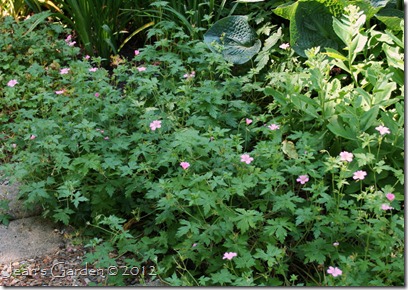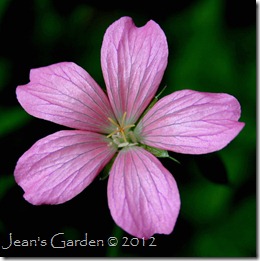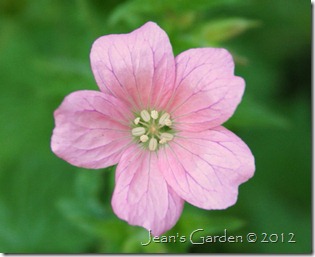From Two Plants to One: My Own ‘Hybrid’ Geranium
 Ten years ago, when I was creating the Deck Border, I bought a division of Geranium x oxonianum ‘A.T. Johnson’ from the garden/nursery of Jean Moss in mid-coast Maine and planted it at the front of the border. I had fallen in love with this plant’s clear pink flowers when I first saw it, and I knew I wanted to grow it in my garden. The following year, when the deck was completed and I was finishing this border, I divided my healthy clump of ‘A.T. Johnson’ and planted a second division of it at the bottom of the deck stairs. Two years later, when my original clump failed to return in spring, I was glad I had divided it and still had some, because Jean Moss had closed her nursery and I had never seen ‘A.T. Johnson’ for sale anywhere else. I replaced it in the original location with a very closely related cultivar, Geranium x oxonianum ‘Wargrave Pink.’ Then, the following year, ‘A.T. Johnson’ staged a come-back, and I now had the two plants growing side-by-side.
Ten years ago, when I was creating the Deck Border, I bought a division of Geranium x oxonianum ‘A.T. Johnson’ from the garden/nursery of Jean Moss in mid-coast Maine and planted it at the front of the border. I had fallen in love with this plant’s clear pink flowers when I first saw it, and I knew I wanted to grow it in my garden. The following year, when the deck was completed and I was finishing this border, I divided my healthy clump of ‘A.T. Johnson’ and planted a second division of it at the bottom of the deck stairs. Two years later, when my original clump failed to return in spring, I was glad I had divided it and still had some, because Jean Moss had closed her nursery and I had never seen ‘A.T. Johnson’ for sale anywhere else. I replaced it in the original location with a very closely related cultivar, Geranium x oxonianum ‘Wargrave Pink.’ Then, the following year, ‘A.T. Johnson’ staged a come-back, and I now had the two plants growing side-by-side.
Some people say these plants are indistinguishable, but there is actually a subtle difference in the colors of their flowers. A.T. Johnson has a slight blue undertone and is often described as a silvery pink; Wargrave Pink has a slight yellow undertone, often described as salmony pink. (I think you can see the difference in the images below.)
 |
 |
| xx |
Over the years, as I have moved these plants around, dividing the clumps and then dividing those divisions, it has become difficult to tell where one plant ends and the other begins. Nevertheless, when I moved a division of Geranium x oxonianum to the Fence Border several years ago and then from there to the Circular Bed this spring (see Musical Plants), I was pretty sure I had taken it from the ‘Wargrave Pink’ side of the clump. But during my ritual morning tour of the garden one day recently, as I looked in satisfaction at this plant now blooming happily in the Circular Bed, I suddenly realized that I was seeing two different colors of flowers. When I moved this plant from the Fence Border, the clump was too big to transplant and I created three other divisions from it; it will be interesting to see whether these also have both types of flowers. It seems that the roots of the two original plants have become so completely intertwined over the years that they can no longer be separated. From what was originally two different plants, I now have my own personal variety of G. x oxonianum, a special hybrid that blooms in two different colors. It makes me smile.

Those look like they may have just enough difference to make a nice contrast growing together – not just color, but shape.
Jason, The difference in shape in these images is misleading — it’s because the best images I had of the two different color flowers were taken at different stages in opening. You can see the salmony colored flower has its anthers clustered together near the center; as the flower opens, both the petals and the anthers spread out. A person walking by this plant would never notice that the flowers were different; you really have to stop and look closely.
Hi Jean, that’s quite special. I like the idea that two plants have completely wrapped around themselves and formed one. I hope your experiment works. We don’t have geraniums because the other half doesn’t like them but they do seem to grow wild everywhere.
It’s too bad that your other half doesn’t like geraniums; they’re key players in my garden. I can imagine, however, that you have many growing wild, since so many of the ones we grow are European natives and so many of the naturally occurring hybrids were discovered in England. (I have both G. x oxonianum and G. x cantabrigiense growing in my garden.) This was more an accident than an experiment — but one of those happy accidents that happen so often in gardening.
I suspect the colour difference is more vivid in life, I notice the quite different petals. I battle to get comparative pictures of my 3ish colours of Plumbago. To the human eye there are more than 2 blues, but to the camera! Same problem with orange and yellow strelitzias.
Diana, The color difference is actually very subtle and you have to be looking for it to see it. I know what you mean, though, about the eye being able to pick up color distinctions that the camera can’t see or that the computer can’t reproduce.
Jean, it sounds like one of those folk tales where lovers are rewarded for their loyalty by being turned into different roses that grow twined around each other. “Geranium” might be harder to cast into verse, though.
I was thinking something about “geranium love”, but Stacy beat me to it, and with great panache.
Stacy and Ricki, You two are so clever; I would never have thought of this. I’m afraid I tend to be more literal minded than literary minded; and while I have no trouble at all with math, I suffer from poetry anxiety. ;-).
That is so exciting Jean…you could patent it and sell it :)…so nice that you have these growing as you must be getting rain…everything drying up here….I love both the colors of pink and how nice to have pink geraniums in the garden.
Donna, Given how quickly these plants form big clumps in my garden, I probably could patent it and sell it. It had only been two years since I had planted a small division in the Fence Border, and I had to divide it into four pieces in order to move it! Out weather has turned dry in the past week, and today was the first day of a week of forecasted heat. After all the rain we had in spring and the first part of June, I thought I had wasted my time putting down the soaker hoses this year. But yesterday when I was touring the garden, I noticed that some of the young plants in the Serenity Garden had crispy edges; so today I started watering — two flower beds a day for about 90 minutes each.
Hi Jean, it looks like they have small flowers as seen in that first photo, what is the diameter? We also have a flower here, but it is a weed, the flowers also looks somewhat like that, color also the same. However, i don’t know its ID.
Andrea, There are hundreds of different species of geraniums; and although most are native to Europe, there are some Asian species, too; so there may well be some that are common in the Philippines (although they tend to be cooler climate plants). Most species have flowers somewhere in the range of 1/2″ – 2″ (1-5 cm). These are about 3/4″ in diameter (about 2 cm). In England and the US, geraniums are often known by the common name “cranesbill” because the elongated seed pods are said to resemble the beaks of cranes. (If you click on the top picture to enlarge it, you might be able to see the seed pods.) The shape of the leaves are pretty characteristic of plants in this genus, and many species also have a prominent pattern of veins in the flower petals. If your plants don’t have any of those characteristics, they’re most likely not geraniums.
I can definitely see the difference in the two pinks! I have a pink geranium, maybe Wargrave Pink, given to me by a gardening friend. I’ve been able to divide the clump several times over the past few years and share with friends. Geraniums are fun that way. Even ‘Rozanne’ has been able to be divided and added to other spots in the garden.
That’s awesome! I have hybrid phlox that are the crosses of multiple phlox from around the garden. I’m always curious to see what the latest seedlings look like when they bloom. Both pinks are beautiful.
Will ivy leaf geraniums grow here in the Philippines and if so can I buy the seed here or get from Europe,thanks
Nice and very informative post. Thanks for sharing.
I have a “peppermint twist” geranium whose blooms have pink and white striped petals. Last month though, it produced a flower cluster with deep salmon pink blossoms. How did this happen?
Hi Cynthia, ‘Peppermint Twist’ is a hybrid Pelargonium, rather than a true Geranium. (The two genera are cousins in the same family of plants, Geraniaceae.) I’m not a botanist nor an expert on Pelargonium, but I can think of two ways this might have happened. (1) Plant color variegation is often unstable. Plants with variegated foliage, for example, often produce leaves that are solid green. Something similar might be happening with the color of your flowers. (2) If you have had the plant in your garden for more than one year and it has set seed, you might have a seedling that is a different color than the parent plant. (As a hybrid, this plant will not come true from seed.)